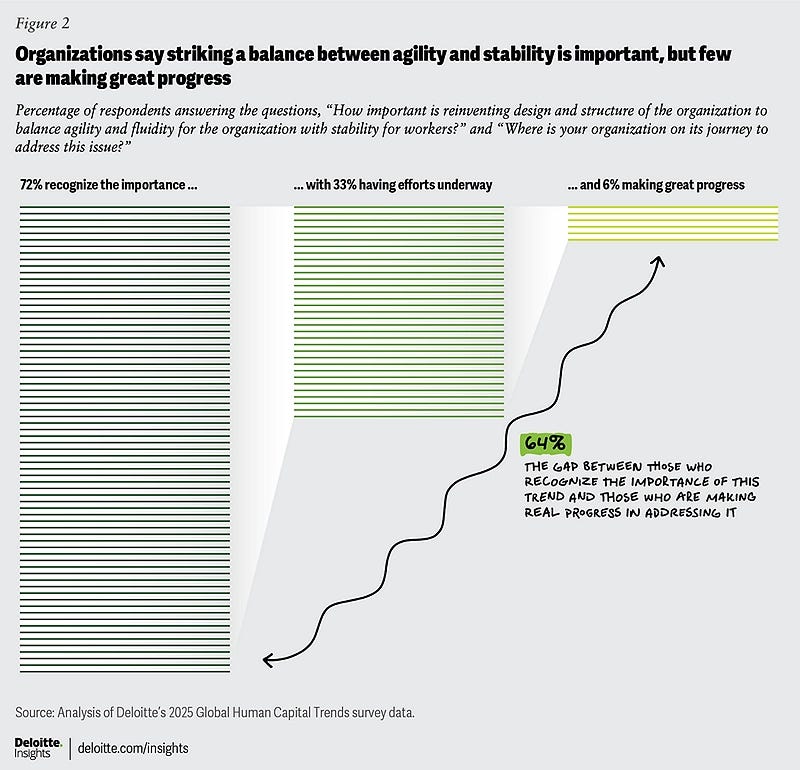
“Leadership today isn’t about balance, it’s about staying upright in motion. It’s about knowing when to pivot, when to pause, and when to push forward.” — Nabeela Elsayed
If you're a leader in the workplace today, chances are, you're tired.
Not just tired in the “I need more sleep” way, but tired in the deeper, more complicated way, like your nervous system has been in a tug-of-war for too long. Like your mind is juggling five priorities while your heart is quietly breaking over decisions that feel impossible.
If your workplace has felt more tense lately, you’re not imagining it.
According to Deloitte’s 2025 Global Human Capital Trends report, we’re leading in a pressure cooker. And today’s leaders aren’t just dealing with one or two challenges. They’re navigating a complex web of competing forces that can’t be easily solved or “balanced.”
The Myth of Balance Is Burning Us Out
Let’s get one thing clear: whether it’s in the workplace or life more broadly, this is not a question of finding balance between two competing priorities.
Balance implies an equal split. A static scale. A mythical equilibrium where competing priorities coexist peacefully. But in today’s workplace, that’s a fantasy.
When your board is demanding better returns and a significant reduction in cost, how do you “balance” that with your team’s need for psychological safety and job stability?
Spoiler: You don’t. You can’t.
Because the nature of cost-cutting creates instability and fear, no matter how carefully we craft the corporate narrative. The moment that optimization, streamlining or financial efficiency gets prioritized at the top of the strategic imperatives, you ripple uncertainty across the organization. And that’s not inherently bad; it is the nature of a corporate organism. And this is something that people need to come to expect, just like the leaves fall off the tree in the fall. Companies will inevitably find a time and place, whether annually or every other year, or during an economic downturn or a change in leadership, when financial performance gets prioritized. And yes, we all like to believe that every business is a people business, and every business is also striving for growth and, at some level, financial stability and health.
So, as a leader, the goal isn’t to balance competing demands like a Zen master in a glass office. The goal is to juggle them. To oscillate between them. To understand that leadership today is more like standing on a moving surfboard than standing on solid ground.
Oscillation > Balance
Rather than aiming for the impossible ideal of balancing people and business, consider this: what leaders need is the capacity for course correction. In some phases of an organization, financial performance will reign supreme, while in other cases, investments in people and culture will take precedence. Rarely, if ever, are they in equilibrium at the same time.
It’s the ability to move along a spectrum between control and empowerment, cost and care, output and outcome and know when to shift, when to pause, and when to recalibrate. Deloitte captures this perfectly in the tensions they outline:
Augmentation ↔ Automation
Personalization ↔ Standardization
Agility ↔ Stability
Outcome ↔ Output
Empowerment ↔ Control
Potential↔ Predictability
These aren’t decisions to resolve. They’re paradoxes to navigate. And navigating them well means letting go of the guilt of not getting it “right” and developing the reflexes to respond wisely to what’s unfolding.
What’s Fueling the Exhaustion?
This is why leadership feels so mentally and emotionally taxing right now.
According to Deloitte’s research:
Most leaders acknowledge their organizations need to become more agile, yet their people are desperately craving more stability.
Leaders are being called to hold two truths at once: move faster and care deeper. Deliver more and burn out less.
And, only 6% of leaders feel confident they’re making substantial progress toward human sustainability.
This is a no-win game if you approach it through the outdated lens of “balance” or simple cause-and-effect strategies. It requires something more advanced: high DI (Decision Intelligence), inner agility, and the ability to lead within the paradox- to lead while holding two competing beliefs at the same time.
So, How Do You DO this?
Stop trying to find a balance between people and business, and start thinking about how you calibrate your approach as a leader.
Calibration is the quiet leadership skill of knowing when to shift gears, when to slow down and when to hold steady.
Calibration is the inner ability to regulate your emotions, successfully holding tensions without panicking, allowing yourself to be emotionally stable and avoid being emotionally hijacked or falling into unhealthy empathy and people pleasing.
Calibration is what is required so that you can oscillate between tensions and lead through ambiguity while still inspire clarity.
Calibration is about being attuned to the degree to which you can influence change or make an impact, so that you don’t lose yourself in the process.
It’s not about getting to the “right” answer. It’s about expanding your capacity to live inside the polarities, the ambiguity, the tension.
Sounds exhausting. Well it can be at first, but once you accept what is in your control and what isn’t, you start to oscillate intelligently- reserving your energy for the things that matter, fighting the battles that you can win, standing your ground when necessary and knowing when to step back and follow because no matter what you might do the outcome wont change.
Re-Imagining Leadership as Tension Management
I recall a time during a massive transformation when the leadership team was overwhelmed. There were countless competing priorities, the organization was in a bit of a tailspin, and people were on the verge of burnout. What people wanted more than anything was clarity, direction, and some stability. Still, the reality is that, as a leader, you can no longer offer stability, and clarity is also becoming increasingly rare. Amongst the leadership team, it became clear that we couldn’t remove the ambiguity or the competing priorities. Still, we could help people figure out how to eat the elephant, so to speak, how to tackle the big, hairy problem in smaller, more manageable steps, break things down to the lowest common denominator.
Were we able to remove the tension? - No
Were we able to prioritize so there were no competing priorities - No
What if leadership success isn’t about fixing the tension, but holding it with more grace?
What if the real work of leadership is:
Not perfecting a decision, but recognizing when it needs to evolve.
Not protecting people from uncertainty, but teaching them how to navigate it.
Not balancing every demand, but making peace with the impossibility of doing it all.
So if you’re feeling stretched, conflicted, or disoriented, know this: you’re not failing. You’re just standing in the leadership fire of the moment we’re all in. And maybe that fire is the crucible for a different kind of leader to emerge
Until next time. Take care of yourself and those around you.
In Partnership,
Nabeela
If you made it to the end, you’ve got range.
For more content on redefining leadership and getting off the the burnout loop, you can:
👉 Follow me on LinkedIn, YouTube or Instagram
🎙️ Listen to the article on the Substack or wherever you get your podcast: Re-Imagine Success Podcast
📨 Or just forward this to a colleague who needs a little perspective (and maybe a little permission to let go of the balancing act).
Want to learn more?
If you would like to learn more about the world's unhealthy relationship with work, success, and achievement and discover ways to escape the burnout loop, check out some of my other posts below:


















Share this post